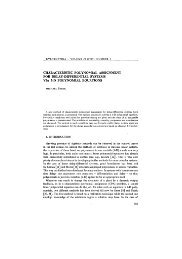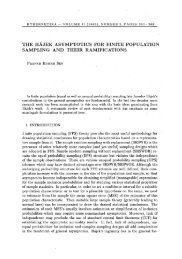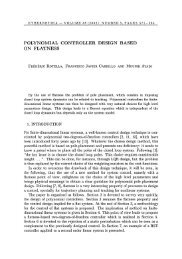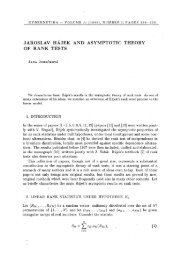tuning the zhu-takaoka string matching algorithm and ... - Kybernetika
tuning the zhu-takaoka string matching algorithm and ... - Kybernetika
tuning the zhu-takaoka string matching algorithm and ... - Kybernetika
You also want an ePaper? Increase the reach of your titles
YUMPU automatically turns print PDFs into web optimized ePapers that Google loves.
Tuning <strong>the</strong> Zhu-Takaoka String Matching Algorithm <strong>and</strong> Experimental Results 77<br />
Table 4. User times in seconds for <strong>the</strong> eight chosen texts.<br />
BM BR BY HOR LDI QS RAI SMI BNR ZHU<br />
Paper 1 103.7 56.0 68.2 71.3 76.6 74.7 59.3 81.3 56.3 169.9<br />
Paper 2 161.8 86.8 106.2 111.2 120.1 116.9 92.4 126.5 87.3 247.1<br />
Paper 3 93.2 50.1 61.2 64.0 69.2 67.4 53.3 72.8 50.4 164.9<br />
Paper 4 26.7 15.5 17.6 18.2 19.8 19.2 15.1 20.9 15.6 85.5<br />
Paper 5 23.3 13.9 15.7 16.2 17.8 17.1 13.5 18.7 14.0 82.2<br />
Paper 6 74.2 40.2 48.7 51.0 54.5 53.2 42.4 58.2 40.4 143.3<br />
Book 2 1195.0 639.0 784.0 820.0 884.0 862.0 681.0 934.0 642.0 1485.0<br />
News 727.0 391.0 476.0 498.0 533.0 520.0 414.0 570.5 393.0 862.0<br />
Table 5. The number of words <strong>and</strong> characters of <strong>the</strong> texts<br />
used in Table 4.<br />
number of woгds number of characters<br />
Paperl 8512 53162<br />
Paper2 13830 82205<br />
PaperЗ 7220 47139<br />
PaperA 2167 13292<br />
Paperô 2100 11960<br />
Paperб 6754 38111<br />
Bookl 139994 773635<br />
Book2 101221 610856<br />
News 53940 37711<br />
6. CONCLUSIONS<br />
The experimental results show that <strong>the</strong> BR <strong>algorithm</strong> is more efficient than <strong>the</strong><br />
existing <strong>algorithm</strong>s in practice for most of our chosen data sets. Over our 4 r<strong>and</strong>om<br />
texts <strong>and</strong> 9 real texts where <strong>the</strong> BR <strong>algorithm</strong> is compared to <strong>the</strong> existing <strong>algorithm</strong>s,<br />
our <strong>algorithm</strong> is more efficient for all but two of <strong>the</strong> texts. With <strong>the</strong> addition of<br />
punctuation <strong>and</strong> capital letters it does not affect <strong>the</strong> BR <strong>algorithm</strong>. So in <strong>the</strong> real<br />
world we would expect our savings to remain <strong>and</strong> make our BR <strong>algorithm</strong> competitive<br />
with <strong>the</strong> existing <strong>algorithm</strong>s. It is also possible to apply some of our findings to what<br />
makes a fast <strong>algorithm</strong> to <strong>the</strong> existing <strong>algorithm</strong>s. This may make <strong>the</strong>m faster but<br />
we were concerned with <strong>the</strong> original <strong>algorithm</strong>s that were devised by <strong>the</strong>ir authors.<br />
ACKNOWLEDGEMENTS<br />
We wish to thank Carl Bamford for comments <strong>and</strong> suggestions made to us during <strong>the</strong><br />
writing of this paper.<br />
(Received May 16, 2000.)<br />
APPENDIX<br />
The figure given in each table is <strong>the</strong> total number of comparisons taken divided by<br />
<strong>the</strong> number of words for <strong>the</strong> pattern length <strong>and</strong> <strong>the</strong>n divided by 1000.






